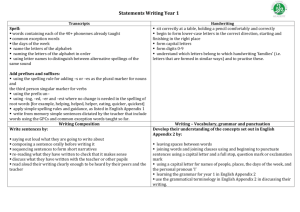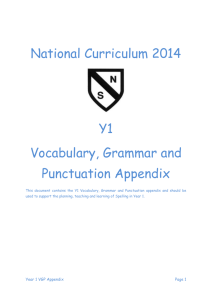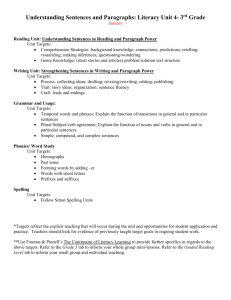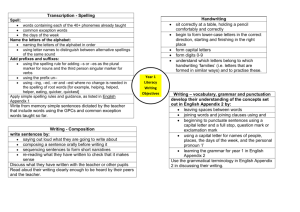Swain House Primary School Writing Assessment Grid Band 1
advertisement
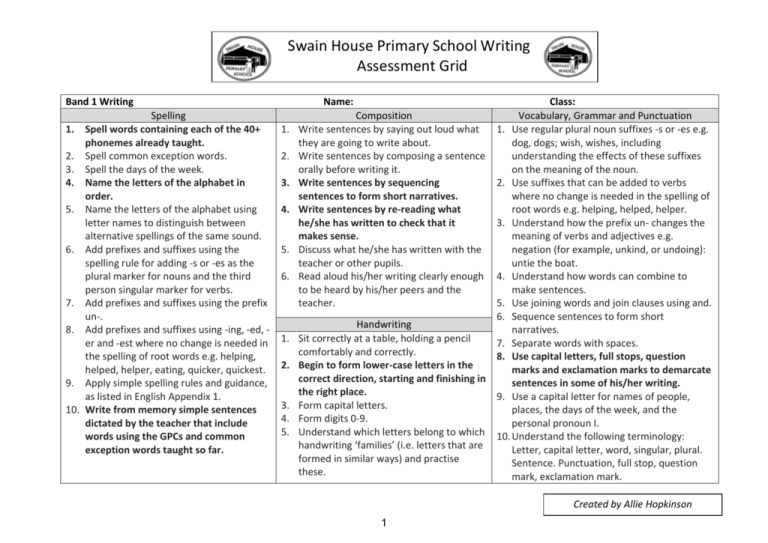
Swain House Primary School Writing Assessment Grid Band 1 Writing Spelling 1. Spell words containing each of the 40+ phonemes already taught. 2. Spell common exception words. 3. Spell the days of the week. 4. Name the letters of the alphabet in order. 5. Name the letters of the alphabet using letter names to distinguish between alternative spellings of the same sound. 6. Add prefixes and suffixes using the spelling rule for adding -s or -es as the plural marker for nouns and the third person singular marker for verbs. 7. Add prefixes and suffixes using the prefix un-. 8. Add prefixes and suffixes using -ing, -ed, er and -est where no change is needed in the spelling of root words e.g. helping, helped, helper, eating, quicker, quickest. 9. Apply simple spelling rules and guidance, as listed in English Appendix 1. 10. Write from memory simple sentences dictated by the teacher that include words using the GPCs and common exception words taught so far. Name: 1. 2. 3. 4. 5. 6. 1. 2. 3. 4. 5. Class: Composition Vocabulary, Grammar and Punctuation Write sentences by saying out loud what 1. Use regular plural noun suffixes -s or -es e.g. they are going to write about. dog, dogs; wish, wishes, including Write sentences by composing a sentence understanding the effects of these suffixes orally before writing it. on the meaning of the noun. Write sentences by sequencing 2. Use suffixes that can be added to verbs sentences to form short narratives. where no change is needed in the spelling of Write sentences by re-reading what root words e.g. helping, helped, helper. he/she has written to check that it 3. Understand how the prefix un- changes the makes sense. meaning of verbs and adjectives e.g. Discuss what he/she has written with the negation (for example, unkind, or undoing): teacher or other pupils. untie the boat. Read aloud his/her writing clearly enough 4. Understand how words can combine to to be heard by his/her peers and the make sentences. teacher. 5. Use joining words and join clauses using and. 6. Sequence sentences to form short Handwriting narratives. Sit correctly at a table, holding a pencil 7. Separate words with spaces. comfortably and correctly. 8. Use capital letters, full stops, question Begin to form lower-case letters in the marks and exclamation marks to demarcate correct direction, starting and finishing in sentences in some of his/her writing. the right place. 9. Use a capital letter for names of people, Form capital letters. places, the days of the week, and the Form digits 0-9. personal pronoun I. Understand which letters belong to which 10. Understand the following terminology: handwriting ‘families’ (i.e. letters that are Letter, capital letter, word, singular, plural. formed in similar ways) and practise Sentence. Punctuation, full stop, question these. mark, exclamation mark. Created by Allie Hopkinson 1 Swain House Primary School Writing Targets Band 1 Writing: Child Speak for setting writing targets Spelling Composition Vocabulary, Grammar and Punctuation 1. I can spell words containing each of the 1. I can write sentences by saying out loud 1. I can add -s or -es to words to make them letter sounds I have been taught. what I am going to write about. plurals e.g. dog, dogs; wish, wishes. 2. I can spell common exception words. 2. I can say my sentence out loud before I 2. I can add -ing, -ed, -est and -er to the end 3. I can spell the days of the week. write it. of a word to make a new word e.g. 4. I can name the letters of the alphabet in 3. I can join my sentences together to make helping, helper. order. a story. 3. I can show you how un- added to the 5. I can name the letters of the alphabet 4. I can read my sentence and check that it beginning of a word can change its using letter names to distinguish between makes sense. meaning. alternative spellings of the same sound. 5. I can talk about my writing with my 4. I can put words together to make 6. I know the plural rule and can use -s and teacher or children in my class. sentences. es in the right place. 6. I can read my sentence out loud so that 5. I can use joining words like ‘and’. 7. I can add un- to the start of a word to children in my class can hear and 6. I can write a short story using sentences. make a different word. understand me. 7. I can use spaces between words. 8. I can add -ing, -ed, -er and -est to the end 8. I can use capital letters, full stops, Handwriting of a word to make a new word e.g. question marks and exclamation marks 1. I can sit correctly at a table, holding a helping, helped, helper, eating, quicker, at the end of sentences. pencil comfortably and correctly. quickest. 9. I can use capital letters for names, 2. I can write lower-case letters in the 9. I can use simple spelling rules. places, the days of the week and the correct direction, starting and finishing in 10. I can write the correct spellings in simple word ‘I’. the right place. sentences I hear my teacher say. 10. I can explain what these words mean: 3. I can write capital letters. letter, capital letter, word, singular, 4. I can write numbers 0-9. plural, sentence, punctuation, full stop, 5. I can see which letters belong to which question mark, exclamation mark. handwriting ‘families’. Created by Allie Hopkinson 2

